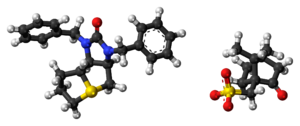 | |
 | |
| Clinical data | |
|---|---|
| Trade names | Arfonad |
| Routes of administration | Oral, IM, IV |
| ATC code | |
| Pharmacokinetic data | |
| Excretion | Renal, mostly unchanged |
| Identifiers | |
| |
| CAS Number | |
| PubChem CID | |
| DrugBank | |
| UNII | |
| KEGG | |
| ChEMBL | |
| CompTox Dashboard (EPA) | |
| ECHA InfoCard | 100.000.633 |
| Chemical and physical data | |
| Formula | C22H25N2OS (free base) |
| Molar mass | 365.52 g·mol−1 |
| | |
Trimetaphan camsilate (INN) or trimethaphan camsylate (USAN), trade name Arfonad, is a sympatholytic drug used in rare circumstances to lower blood pressure.
Trimetaphan is a ganglionic blocker: it counteracts cholinergic transmission at a specific type of nicotinic acetylcholine receptors in the autonomic ganglia and therefore blocks both the sympathetic nervous system and the parasympathetic nervous system. It acts as a non-depolarizing competitive antagonist at the nicotinic receptor, is short-acting, and is given intravenously.
It was discovered by Leo Sternbach.[1]
- ^ Bause GS (1 August 2017). "From Coenzyme R to "Arfonad" and from Vitamin H to Hypotension". Anesthesiology. 127 (2): 381–381. doi:10.1097/ALN.0000000000001771. ISSN 0003-3022.